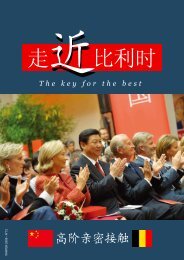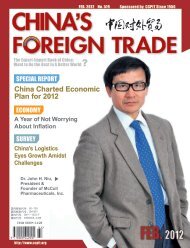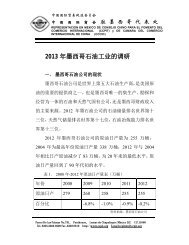Blossom of fitness and family healthcare equipmentAnother major feature of the exhibition isthe impressive presence of the fitness and familycare equipment, which took half of the 10,000square meters exhibition space in the New ChinaInternational Exhibition Center.As the natural environment deteriorates,and the work pressure increases, Chinese peopleare growingly aware of the importance of sportsand health, resulting in the blossom of the fitnessand family health care equipment industry. TheU.S. economist Paul Pilzer said the health industryis becoming the 5th wave of wealth after theIT industry. Faced with tough competition, companieshave to focus on innovation and technologydevelopment. The reporter learned from theexhibition that established companiesin the industry are those withinnovative, high-tech products.Chinese sports goodsindustry pressured toupgradeThe Report on China SportsGoods Industry in 2010 and 2011was released during the exhibition,the first one of its kind. According to thereport, China-made products take 65% of theworld’s sports goods market. However, theChinese sports goods industry is big but notstrong.Due to high inventory and rising costs, theexpansion rate of the industry is declining, whichwill intensify competition.A good thing to note is that China’s sportsgoods industry is increasingly concentrated inGuangdong, Fujian, Jiangsu, and Zhejiang provinces,Beijing and Shanghai, with a concentrationrate of over 85%.The report said that sports equipment hasoutrun sports shoes and clothing in terms of salesand growth rate. In 2010, the eight sports goodslisted companies reported a revenue of 16.146billion yuan in the sports clothing business, anincrease of 25.89% year on year; 13.198 billionyuan in the sports shoes business. While, sportsequipment enterprises above the designated sizerealized a revenue of 83.043 billion yuan. Sportsequipment also made the greatest contribution toChina’s exports of sports goods. In 2011, Chinaexported $15.916 billion worth of sports goods,with a trade surplus of $15.24 billion. Sportsequipment contributed 28.87% to the exportsvolume.The high-end sports shoes and clothingmarket is dominated by foreign brands. But localbrands have started to participate in the competition,and some of them are competitive. The hugemid- and low-end market is dominated by localbrands. In contrast, the sports equipment marketis dominated by local brands, with foreign oneshaving little voice.The report pointed out the challenges facingthe industry. First, Chinese enterprises are in lackof core competitiveness, and recognized brands.They are still at the bottom of manufacturing ofthe global ladder of labor division. Second, shoddyand counterfeit products are rampant, and thecompetition among companies has overheated.With the erosion of the advantages in labor cost,Chinese sports goods producers have to upgradetheir industrial structure.Li Ning, Anta and other Chinese sportsbrands should design more function-specificclothes and shoes, according to Weijishan, chairmanof the World Federation of Sports GoodsIndustry. Currently, the Chinese market doesnot have a huge demand of functional clothesand shoes, which are often expensive. However,with the growth of the economy, people will havemore professional needs and function-specificproducts will be in need. He added that he wasglad to see the growing popularity of mass sportsin China.47
China’s Aging PopulationBrings Opportunitiesfor InsurersBy Richard ZhuThe rapidly aging populationin China is a greatchallenge for the country’sdevelopment and socialsecurity system, while it presents opportunitiesfor insurance companies,according to a recent report by TheBoston Consulting Group (BCG)and Swiss Re.“Insurance companies must developa concrete plan for where andhow to participate to take advantageof the challenges and opportunitiesof aging,” said the report.The aging populationAging is a global phenomenon,and China is no exception. For decades,China has benefited from a“demographic dividend.” Its robustpopulation structure has driven aprolonged period of socioeconomicgrowth. However, as China’s workforceages and moves towards retirement,the country will join manyothers in facing up to the challengesof supporting an aging population,said the report.Over the next five years, thegrowth of China’s workforce, whichhas long contributed to the expansionof the country’s booming economy,will finally slow down and eventuallybecome negative. The workingage population will peak in size in2015 and then begin to decline.Indeed, the silver segment isgrowing fast in China. By 2050, thisgroup will represent more than onethirdof the country’s total population,an eye-popping 439 millionpeople, a far greater number thaneven in Japan, another nation facingsevere demographic shifts.“By 2050, China will be most‘aged’ among BRIC countries with amuch larger 60-and-over populationsize,” said Robert Wiest, President ofSwiss Re China.The scale of China’s aging populationis much greater than that ofother RDEs. The silver segment as apercentage of the total population willnearly triple from the current 12 percentto 34 percent by 2008, a muchhigher increasethan those forecastfor other BRICcountries and far exceedingthe estimated increase indeveloped countries.In China, as elsewhere, theaging population is driven by bothlower fertility rates and increasedlongevity. Life expectancy at birthincreased from under 45 years of agein 1955 to 73 years of age in 2010,a level approaching that of developedcountries. Four specific factorsare responsible for the fact that theimpact of aging in China will beparticularly severe: the rise of themiddle class, the “One Child Policy”,the 4-2-1 (four grandparents, twoparents, one child) family structureand urbanization.Overall, the report pointedout that China’s aging populationwill have three major implicationsfor companies and for the country’seconomy:Historically, China’s economic48

















